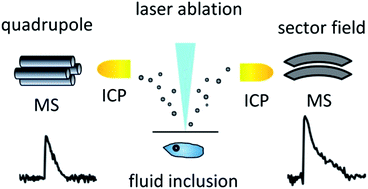Fluid inclusion measurements by laser ablation sector-field ICP-MS
Abstract
A state-of-the-art, highly sensitive sector-field inductively coupled plasma mass spectrometer (SF-ICP-MS) was evaluated for analyzing fluid inclusions in combination with a 193 nm excimer laser ablation, with the aim of expanding the technique to smaller inclusions and/or lower element concentrations. A well-defined assemblage of numerous co-genetic fluid inclusions and thin layers (50 nm) of chromium and copper containing traces of gold were studied regarding reproducibility and detection limits. For comparison, aliquots were analyzed with a quadrupole (Elan 6100 DRC) and the SF-ICP-MS instrument (Element XR). While using an element menu of 21 elements covering the mass range from lithium (7 amu) to lead (208 amu), approximately ten times lower detection limits were found for the SF-ICP-MS, whereby the cycle time increased by only 20% compared with the quadrupole instrument. An absolute detection limit for e.g. gold of 1 femtogram (10−15 g) was found for fluid inclusions analysis. Detection efficiencies of 2.6 × 10−5 counts per ablated atom for copper and 3.1 × 10−5 for chromium were determined by ablating the thin layers. The detection efficiency for sodium in the fluid inclusions was 2 × 10−7, about five times lower than that expected from the sensitivity obtained on NIST SRM 610 glass.

- This article is part of the themed collection: Geological applications of laser ablation

 Please wait while we load your content...
Please wait while we load your content...